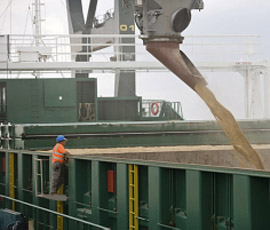Tight world grain supply set to fuel volatility

Increasingly tight grain stocks along with production responses to price swings are set to create more volatility, grain market analysts warned at this week’s HGCA Grain Market Outlook Conference.
Both wheat and maize needed to see demand rationing, said HGCA senior analyst Jack Watts. This is when prices makes it uneconomical to use grains for some purposes, for example as animal feed. The effect of this is to allow stocks to build once more.
Maize is already seeing demand rationing, with global demand falling for the first time in many years. Cattle finishers in the USA were losing US$300 a head, said corn (maize) trader Michael O’Dea of INTL FC Stone.
With extreme weather becoming the norm, small harvests were getting smaller and big harvests bigger, exaggerating swings in production, the conference heard. This, combined with an uncertain global economic outlook and demand rationing, will also add to volatility.
However, the long-term trend of rising demand for grain should continue, said Mr Watts, while political and global economic influences may increase.
World wheat production in 2012-13 is expected to be about 653m tonnes, compared with 659m tonnes last season. Lower crops in Australia, the EU and Russia will push end of season stocks to 173m tonnes, representing about three months’ consumption.
While this was not tight, it was less abundant, said Mr Watts. “But the stocks to use ratios for major exporters are of concern,” he said. It was important to avoid a repeat of the 2007-08 season, when the world effectively ran out of export wheat. “The one thing standing between the situation now and 2007-08 is the US.”
US wheat stocks are set to rise to 17.8m tonnes this season compared with about 8m tonnes last year, while India holds more than 22m tonnes and is also potentially an important exporter, although quality was uncertain and politics may interfere, said Mr Watts.
In the maize market, the impact of the US drought on the current and following crop is the big issue. “A tight situation just got a lot tighter,” said Mr Watts. End of season stocks are set to fall to about 117m tonnes, or just seven weeks’ consumption.
Crop market roundup
Wheat and maize –
- Lower global wheat and maize outputs
- Tight supply and tightening stocks
- High prices starting to lead to demand rationing
- Increasing reliance on South American maize crop
- Fund/speculator activity likely to exaggerate the reaction to any fresh supply and demand news
- Declining exporter wheat stocks
- Wheat set to be a more assertive grain in future, building a premium over maize and being led less by maize prices
- World grain stocks vulnerable to weather in 2013-14 season
Barley –
- Global barley production and consumption finely balanced
- Argentina a rapidly growing barley exporter
- Rebound in French barley production and reasonable quality is keeping EU premiums low
- Barley will benefit from tight wheat and maize markets
- Prices supported by strong feed grain market
Oats –
- Increasingly important niche crop – UK demand ahead of production
- To maintain sufficient supplies, growers need a pre-planting price signal
Oilseeds –
- Record soya bean plantings in Brazil and Argentina
- Seasonal peak in palm oil output is reducing prices and limiting wider vegetable oil price rises
- Soya bean prices are high but rising soya meal prices support crush margins
- World more reliant than ever on approaching South American soya bean crop – any weather threat will result in volatility
- Rapeseed expected again to be in tight supply – weather issues in EU and Canada focuses attention toward Australia and it ability to export
